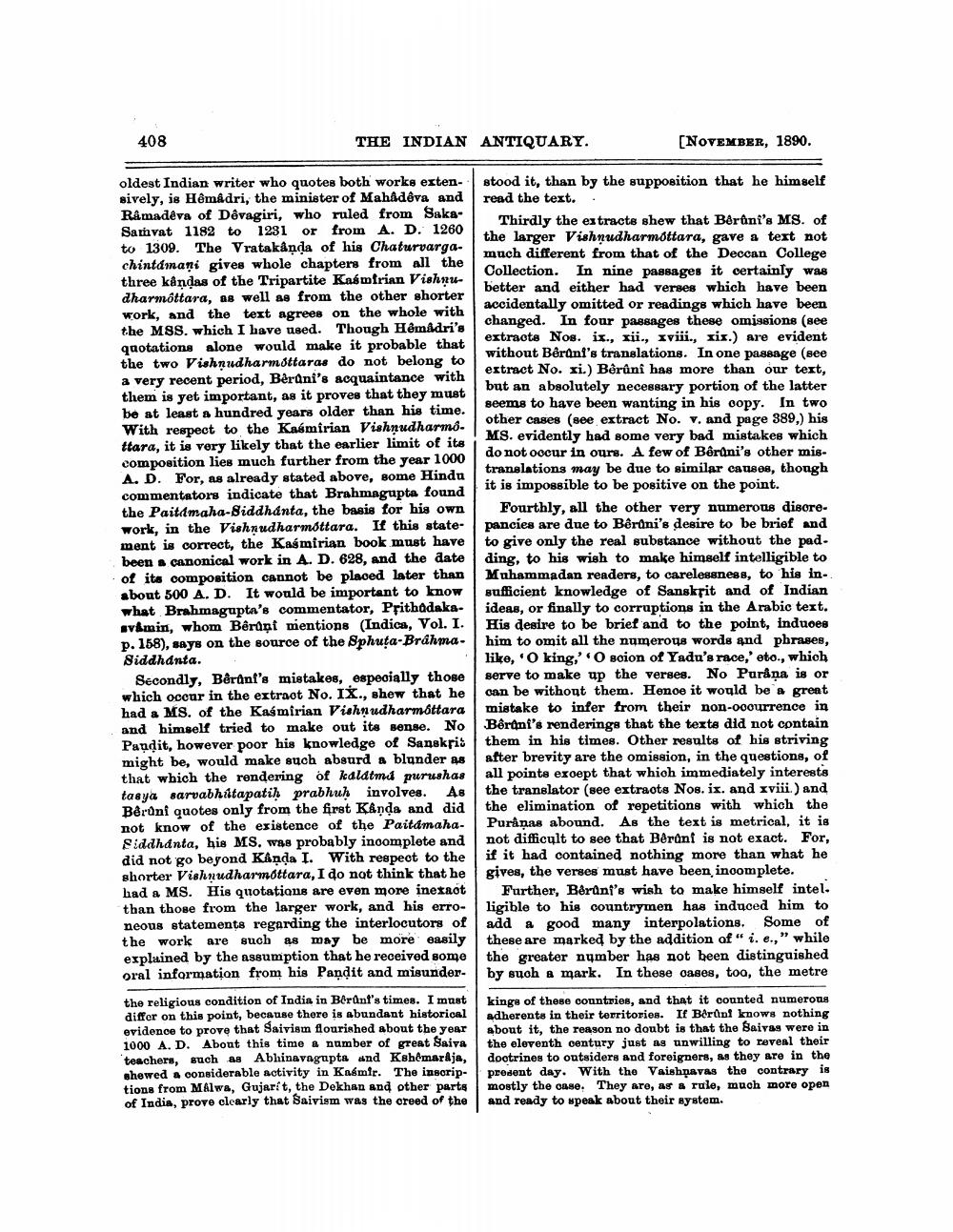________________
408
THE INDIAN ANTIQUARY.
[NOVEMBER, 1890.
oldest Indian writer who quotes both works exten- sively, is Hêmadri, the minister of Mahadeva and Ramadera of Dêvagiri, who ruled from SakaSamvat 1182 to 1231 or from A. D. 1260 to 1309. The Vratakânda of his Chaturvargachintamani gives whole chapters from all the three kändas of the Tripartite Kasmirian Vishdharmóttara, as well as from the other shorter work, and the text agrees on the whole with the MSS. which I have used. Though Hêm dri's quotations alone would make it probable that the two Vishnudharmóttaras do not belong to a very recent period, Berani's aoquaintance with them is yet important, as it proves that they must be at least a hundred years older than his time. With respect to the Kasmirian Vishnudharmo. ttara, it is very likely that the earlier limit of its composition lies much further from the year 1000 A. D. For, as already stated above, some Hindu commentators indicate that Brahmagupta found the Paitamaha-Siddhanta, the basis for his own work, in the Vishnudharmóttara. If this state- ment is correct, the Kasmirian book must have been canonical work in A. D. 628, and the date of its composition cannot be placed later than about 500 A. D. It would be important to know what Brahmagupta's commentator, Prithadaka. av min, whom Bêrunt mentions (Indica, Vol. I. p. 168), says on the source of the Sphuta-BrahmaSiddhanta.
Secondly, Bêrant's mistakes, especially those which occur in the extract No. IX., shew that he had a MS. of the Kasmirian VishŅudharmóttara and himself tried to make out its sense. No Pandit, however poor his knowledge of Sanskris might be, would make such absurd a blunder 48 that which the rendering of kaldtmu purushas tasya sarvabhitapatih prabhuh involves. As Bêruni quotes only from the first Kanda and did not know of the existence of the PaitamahaSiddhanta, his MS, was probably inoomplete and did not go beyond Kanda I. With respect to the shorter Vishnudharmóttara, I do not think that he had a MS. His quotations are even more inexaot than those from the larger work, and his erro- neous statements regarding the interlocutors of the work are such as may be more easily explained by the assumption that he received some oral information from his Pandit and misunder
stood it, than by the supposition that he himself read the text..
Thirdly the extracts shew that Bérôni's MS. of the larger Vishnudharmóttara, gave a text not much different from that of the Deccan College Collection. In nine passages it certainly was better and either had verses which have been accidentally omitted or readings which have been changed. In four passages these omissions (see extracts Nos. ix., xii., xviii., xix.) are evident without Bérant's translations. In one passage (see extract No. xi.) Bôrûnî has more than our text, but an absolutely necessary portion of the latter seems to have been wanting in his oopy. In two other cases (see extract No. v. and page 389,) his MS. evidently had some very bad mistakes which do not oocur in ours. A few of Bêrani's other mis. translations may be due to similar causes, though it is impossible to be positive on the point.
Fourthly, all the other very numerous disore. pancies are due to Bêruni's desire to be brief and to give only the real substance withont the nad. ding, to his wish to make himself intelligible to Muhammadan readers, to carelessness, to his insufficient knowledge of Sanskrit and of Indian ideas, or finally to corruptions in the Arabic text. His desire to be brief and to the point, induces him to omit all the numerous words and phrases, like, 'O king,'' soion of Yadu's race,' eto., which serve to make up the verses. No Puråņa is or can be without them. Henoe it would be a great mistake to infer from their non-ooourrence in Bêrtni's renderings that the texts did not contain them in his times. Other results of his striving after brevity are the omission, in the questions, of all points except that which immediately interests the translator (see extraots Nos. ix. and xviii.) and the elimination of repetitions with which the Puriņas abound. As the text is metrical, it is not difficult to see that Bérant is not exact. For, if it had contained nothing more than what he gives, the verses must have been incomplete.
Further, Berunt's wish to make himself intel. ligible to his countrymen has induced him to add a good many interpolations. Some of these are marked by the addition of " i. e.," while the greater number has not been distinguished by such a mark. In these cases, too, the metre kings of these countries, and that it counted numerous adherents in their territories. If Berunt knows nothing about it, the reason no doubt is that the Baivas were in the eleventh century just as unwilling to reveal their dootrines to outsiders and foreigners, as they are in the present day. With the Vaishnavas the contrary is mostly the case. They are, as a rule, much more open and ready to speak about their system.
the religious condition of India in Berunt's times. I must differ on this point, because there is abundant historical evidence to prove that Saivism flourished about the year 1000 A. D. About this time a number of great Saiva teachers, such as Abhinavagupta and Kshēmarája, shewed a considerable activity in Kasmir. The inscriptions from Malwa, Gujarít, the Dekhan and other parts of India, prove clearly that saivism was the creed of the




